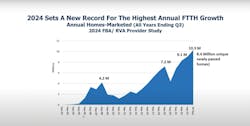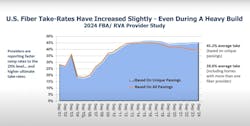Fiber-based broadband continues to gain momentum as a broadband medium, with more consumers opting for the service if it is available in markets where cable is present.
A new Fiber Broadband Association Fiber Deployment survey with RVA Market Research & Consulting (RVA) revealed that fiber broadband deployments reached a new annual record of 10.3 million U.S. homes passed in 2024.
The 2024 survey data suggests that fiber now passes 56.5% of U.S. households. Fiber take rates increased slightly in 2024, growing to an average of over 45% based on unique passings. Service providers are achieving their first 20% take rate much faster and reaching higher take rates over time.
Mike Render, Founder and CEO of RVA, said that “there is a lot more runway left to go” to grow the fiber base even further.
“Cumulatively, we’re now at 76 million unique homes passed,” Render said in a recent Fiber for Breakfast webinar about the new study. “If you count passings from providers that are doubling up and are passing a home more than once with more than one provider, there’s 88.1 million passings.”
With 14 percent growth, Render said, “We’re now at 35 million homes connected to fiber, and take rates are holding up.”
Beating cable
Among the customers who churned in the past two years, fiber’s main competitor, HFC cable, had a net loss of 33% in areas where fiber was available.
RVA predicts cable will continue to see customers migrate to fiber and cable providers replace their legacy plants with fiber.
While HFC cable has several benefits, such as speed and latency, many customers are still churning to fiber.
Notably, more customers are choosing a fiber provider for broadband in areas where fiber is available alongside HFC.
During the fourth quarter, the two largest cable operators—Comcast and Charter—once again saw their broadband subscriber bases decline. Comcast shed 139,000 broadband subscribers, while Charter lost 177,000.
AT&T and Verizon added 307,000 and 51,000 fiber subscribers during the fourth quarter.
“Fiber won in terms of new customers and churn,” Render said. “Where fiber isn’t available, cable is holding its own, but fixed wireless picked up won with new customers.”
Render added that while the cable industry is banking on DOCSIS 4.0 as a way to battle fiber more effectively, “the churn will still occur rapidly to fiber because 65 percent think fiber is the best, as well as latency and other factors.”
Take rates rising
As providers pass more homes and connect them to fiber, fiber take rates hold their own.
RVA noted that while taking rates dip during periods of strong growth—a phenomenon that took place when Verizon started to roll out Fios in 2004—ramp rates are rising and growing faster.
“Many providers are getting to that first 20 percent take rate at a faster period and getting to higher take rates,” Render said. “We’re now looking at an average take rate of 45 percent.”
These numbers show that the fiber broadband industry is approaching the FBA’s 90 percent passed and 50 percent connected goal.
“It looks like we’re generally on the right path,” Render said. “There’s still much room to grow with 50 percent of households, but only 18 percent of second homes.”
Inventory glut ending
Another potential sign of relief is that the fiber industry’s inventory issues generated by COVID-era stockpiling are now resolved.
RVA noted that the average month of inventory estimates is steadily going down.
Fiber cable had the most extensive excess inventory, almost past this period.
“After a deficit of materials happened and COVID occurred, everyone realized the value of the internet, and suddenly, people were overbuying,” Render said. “Now you see service providers are working out the inventory, and most vendors are working their way back up.”
However, Render cautioned that while the trends are better, “the numbers are not back to the trend line, and vendors have not seen the sales they would like to see or will see.”
Corning, for example, reported that fourth-quarter Carrier Network sales grew year-over-year.
Considering carrier customer conversations and public announcements, the company expects continued carrier growth in 2025 and beyond.
“As part of our cyclical trend there, what we said is that the carriers have overdone inventory relative to deployment, and those two things would come into line, and then we'd start to see recovery,” said Corning CEO Wendell Weeks. “We see the beginning of that, right, but we'd like to see more."
Investment to continue
The 2024 North American Fiber Provider Survey suggests substantial investment in fiber will continue across private equity, mergers and acquisitions, capex reinvestment, and public funds.
During the 2025-2029 period, we could see more than a 50% increase in homes passed and more than a 100% increase in route miles to support homes passed.
Another growth element will come from a few sources: new households and new fiber competitors. Many initial passings are also to be had in dense low-income areas, high-income areas, rural areas, and second homes.
“There’s still 71 million homes to be passed, but beyond that, we’re seeing more and more second passings,” Render said. “People are realizing how strong fiber is and that there’s no other medium that has the degree of differentiation that fiber has, so they are looking at competing with another fiber provider in many areas.”
Investments in fiber broadband continue to flow. Over the past five years, private equity and new acquisitions have become increasingly involved.
T-Mobile and Bell Canada, for one, have been active. T-Mobile is in the process of purchasing Lumos and Metronet, while Bell is making a move on Ziply Fiber.
“Mergers and acquisitions are taking place even from companies from Canada, which tends to add money to the pot,” Render said.
Capital spending increases from AT&T and Verizon are also notable.
AT&T had $22 billion in capital investment in 2024 and plans to see the same in 2025 as it continues to focus on modernizing its wireless network, expanding its fiber footprint, and improving customer experience.
Likewise, Verizon has set an aggressive spending pattern for FTTH. In addition to its commitment to reach nearly 700,000 homes with Fios this year, it has made a bid to acquire Frontier Communications.
Frontier’s 2.2 million fiber subscribers across 25 states will join Verizon’s approximately 7.4 million Fios connections in 9 states and Washington, D.C. In addition to Frontier’s 7.2 million fiber locations, the company is committed to building an additional 2.8 million fiber locations by the end of 2026.
“AT&T and Verizon announced good capex increases for the future, so that’s exciting,” Render said.
Much public funding will also be used to support fiber builds, including $64 billion from Rural Utility Service (RUS) and the Treasury. Additionally, the disbursements for the $42 billion BEAD program have begun.
“All in all, there’s a huge amount of capital being deployed in the market,” Render said.
BEAD’s influence
The U.S. government’s Broadband Equity, Access, and Deployment (BEAD) program, created under the Biden-Harris administration, will continue to make inroads this year.
Louisiana, Maryland, and Nevada have received BEAD broadband funds.
While keeping a fiber preference will create challenges for some high-cost areas, Render maintains that “BEAD will be significant.”
A key question is whether the new administration will continue to support fiber-based broadband for BEAD. Elon Musk, the creator of the Starlink LEO satellite service overseeing the administration’s DOGE department, will try to garner more support.
“The grassroots support for fiber is firm,” Render said. “I am hopeful the administration will remove some of the hard regulation edges, but I don’t think the preference will change, and most state broadband offices prefer fiber.”
Permitting and labor challenges
Despite the strength of fiber-based broadband, the industry will continue to struggle with permitting and labor shortages.
Service providers still have to navigate and negotiate rates to access rights of way, utility poles, and access to federal lands.
“Permitting is this year’s top provider challenge,” Render said. “For larger providers, permitting and shutting down copper will be key issues.”
USTelecom noted in a letter to President Donald Trump and Congress that obtaining federal permits is slow. In Utah, one provider waited almost three years for permission to repair an existing fiber line on federal lands.
The cost of labor was a key constraint for smaller service providers. About a quarter of RVA’s survey respondents said it was a significant constraint.
“It has not yet become a major constraint, but it is creeping up there,” Render said. “If we continue to grow with private money and the BEAD money coming together, it could become a problem.”
For related articles, visit the Broadband Topic Center.
For more information on high-speed transmission systems and suppliers, visit the Lightwave Buyer’s Guide.
To stay abreast of fiber network deployments, subscribe to Lightwave’s Service Providers and Datacom/Data Center newsletters.
Fiber broadband Consolidation ahead
Consolidation in the regional fiber broadband market will continue accelerating over the next year. According to a survey conducted by AlixPartners last fall, more than 400 small fiber providers in the U.S. “are ripe for picking by investors or larger fiber companies when the inevitable major fiber consolidation wave occurs.”
Alix Partners estimates that there are about 1,900 small-scale fiber companies in the U.S., about 1,000 of which are either electric co-ops or linked to more prominent energy players. AlixPartners estimates that roughly 400 of the remaining 900 small-scale fiber companies are meaningful candidates for mergers and acquisitions.
Broadband equipment spending to peak at $19.2B by 2028
According to a new Dell’Oro Group report, the broadband access equipment market is forecasted to grow 0.8 percent on average for the next five years (2024-2029), with total revenue expected to peak in 2028, as cable operators and fiber ISPs complete major DOCSIS 4.0 and rural broadband expansion projects.
Driven by XGS-PON deployments in North America, EMEA, and CALA, as well as FTTR (Fiber to the Room) and 50 Gbps deployments in China, the research firm forecasts that PON equipment revenue will grow from $10.5 billion in 2024 to $12.1 billion in 2029. Likewise, Cable Distributed Access Equipment is predicted to peak at $1.3 billion in 2028 as operators continue their DOCSIS 4.0 and early fiber deployments.
About the Author
Sean Buckley
Sean is responsible for establishing and executing the editorial strategy of Lightwave across its website, email newsletters, events, and other information products.





